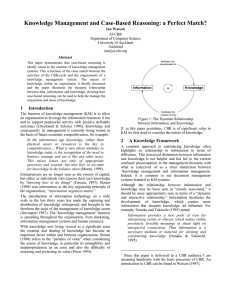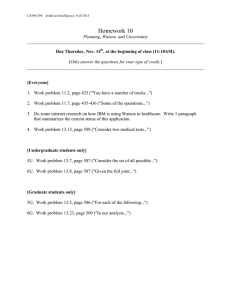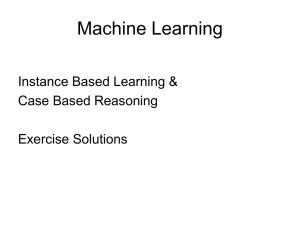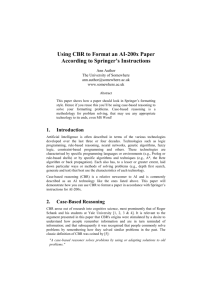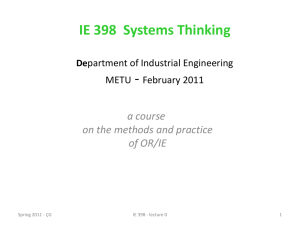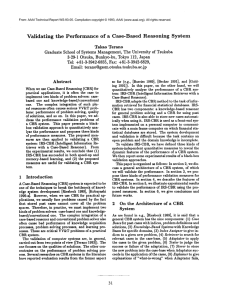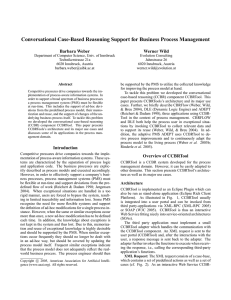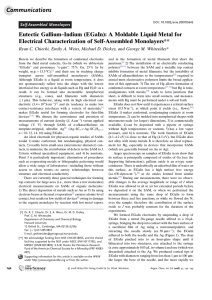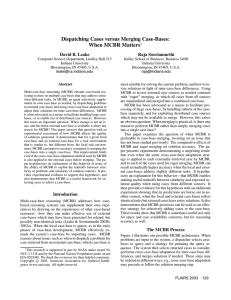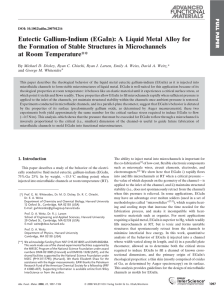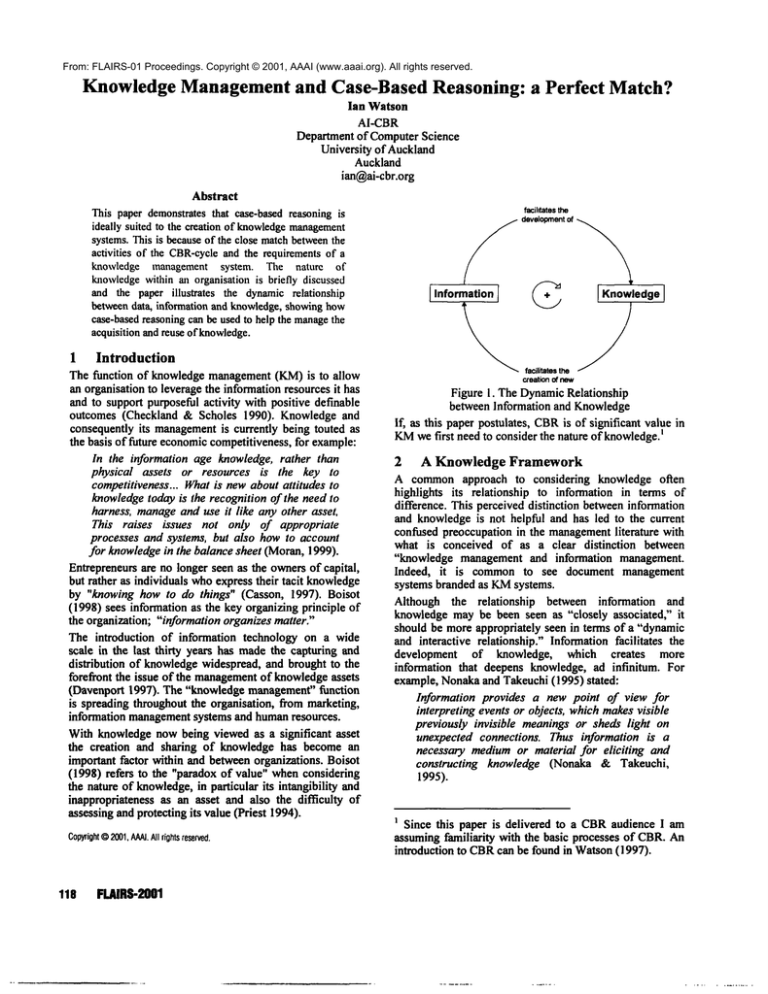
From: FLAIRS-01 Proceedings. Copyright © 2001, AAAI (www.aaai.org). All rights reserved.
Knowledge Managementand Case-Based Reasoning: a Perfect Match?
lan Watson
AI-CBR
Department of ComputerScience
University of Auckland
Auckland
ian@ai-cbr.org
Abstract
This paper demonstratesthat case-basedreasoningis
ideally suited to the creation of knowledge
management
systems.Thisis becauseof the close matchbetweenthe
activities of the CBR-eycle
and the requirementsof a
knowledge management system. The nature of
kalowledge
withinan organisationis briefly discussed
and the paper illustrates the dynamicrelationship
betweendata, informationand knowledge,showinghow
case-basedreasoningcan be usedto help the manage
the
acquisition and reuse ofknowledge.
1
Introduction
The function of knowledgemanagement(KM)is to allow
an organisationto leveragethe informationresourcesit has
and to support purposefulactivity with positive definable
outcomes (Checkland & Scholes 1990). Knowledgeand
consequently its management
is currently being touted as
the basis of future economiccompetitiveness,for example:
In the information age knowledge, rather than
physical assets or resources is the key to
competitiveness... Whatis newabout attitudes to
knowledgetoday is the recognition of the need to
harness, manageand use it like any other asset.
This raises issues not only of appropriate
processes and systems, but also how to account
for knowledgein the balance sheet (Moran,1999).
Entrepreneursare no longer seen as the ownersof capital,
but rather as individuals whoexpress their tacit knowledge
by "knowing how to do things" (Casson, 1997). Boisot
(1998) sees information as the key organizing principle
the organization; "information organizesmatter."
The introduction of information technology on a wide
scale in the last thirty years has madethe capturing and
distribution of knowledgewidespread, and brought to the
forefront the issue of the management
of knowledgeassets
(Davenport 1997). The "knowledgemanagement"function
is spreading throughoutthe organisation, from marketing,
information management
systems and humanresources.
With knowledgenowbeing viewed as a significant asset
the creation and sharing of knowledge has become an
important factor within and betweenorganizations. Boisot
(1998) refers to the "paradox of value" whenconsidering
the nature of knowledge,in particular its intangibility and
inappropriateness as an asset and also the difficulty of
assessing and protecting its value (Priest 1994).
Copyright
©2001,A,~I. All rights reserved.
11e
FLAIRS-2001
facihtatesthe
I,°,ormat,onl
I .ow’
",ol
creation of m~
Figure 1. The DynamicRelationship
between Information and Knowledge
If, as this paper postulates, CBR
is of significant value in
KMwe first need to consider the nature of knowledge)
2
A Knowledge Framework
A commonapproach to considering knowledge oRen
highlights its relationship to information in terms of
difference. This perceiveddistinction betweeninformation
and knowledgeis not helpful and has led to the current
confused preoccupation in the management
literature with
what is conceived of as a clear distinction between
"knowledge managementand information management.
Indeed, it is commonto see document management
systems branded as KMsystems.
Although the relationship between information and
knowledgemaybe been seen as "closely associated," it
should be more appropriately seen in terms of a "dynamic
and interactive relationship." Informationfacilitates the
development of knowledge, which creates more
information that deepens knowledge, ad infinitum. For
example, Nonakaand Takeuchi(1995) stated:
Information provides a new point of view for
interpreting events or objects, whichmakesvisible
previously invisible meaningsor sheds light on
unexpected connections. Thus information is a
necessary mediumor material for eliciting and
constructing knowledge (Nonaka & Takeuchi,
1995).
Since this paper is delivered to a CBRaudience I am
assumingfamiliarity with the basic processes of CBR.An
introduction to CBRcan be found in Watson(1997).
fi
Perceptual
andconceptual
filters
...................................
p, !
:
p’,
Event
(experientialdatasource)
Agent
(tacit knowledae
source)
I
Information
Data
-~-
Feedback
.......................
J
Source:Adaptedfrom Boisot (1998)
Figure2. Data,InformationandKnowledge
(Boisot, 1998)
Whilst Polyani (1967) and Choo(1998) have viewed
dynamicinteractive relationship as part of the process of
knowingwhichfacilitates the capacity to act in context.
The dynamicnature of this relationship is illustrated below
in Figure1.
Similarly, to look at information purely in terms of the
degree to which it has been processed, i.e., the data,
information, knowledge hierarchy (Davenport 1997;
Checkland & Howell 1998) oversimplifies the complex
relationship betweenthe three intangibles. Stewart (1997)
notes:
The idea that knowledgecan be slotted into a datawisdomhierarchy is bogus, for the simple reason
that one man’s knowledge is another man’s data
(Stewart 1997).
The categories defined by Boisot and their interactions
maybe seen in Figure 2. It is important to note the
feedback element within this figure that illustrates the
dynamicand interactive relationship of information and
knowledgeas a positive feedbackloop.
Datais discriminationbetweenstates - black, white, heavy,
light, dark, etc. - that mayor maynot conveyinformation
to an agent. Whetherit does or not dependson the agents
prior stock of knowledge.For example,the states of nature
indicated by red, amberand green traffic lights maynot be
seen as informative to a bushmanof the Kalahari. Yet,
they mayperceivecertain patterns in the soil as indicative
of the presenceof lions nearby.
Thus, whereasdata can be characterised as a property of
things, knowledgeis a property of agents predisposing
themto act in particular circumstances.Informationis that
subset of the data residing in things that activates an agent
- it is filtered fromthe data by the agent’s perceptual or
conceptualapparatus (Boisot, 1998). This has a direct echo
in AlanNewell’sprinciple of rationality:
"If an agent has knowledgethat one of its actions
will lead to one of its goals, then the agent will
select that action" (Newell1982)
3
CBR is a methodology for KM
What then are the requirements of a KMsystem? At a
recent workshopheld at CambridgeUniversity a group of
people active in KMand AI identified the mainactivities
needed by a KMsystem (Watson 2000). These were
mapped to AI methods or techniques. The main KM
activities were identified as the: acquisition, analysis,
preservation and use of knowledge.This section will show
howCBRcan meet each of these requirements.
I argued in 1999 that CBRis not’an AI technology or
technique like logic programming,rule-based reasoning or
neural computing. Instead, CBRis a methodology for
problem solving (Watson 1999). Checkland & Scholes
(1990) define a methodologyas:
"...an organised set of principles which guide action in
trying to "manage" (in the broad sense) real-world
problem situations" (Checkland&Scholes 1990)
Nowconsider the classic definition of CBR:
".4 case-based reasoner solves problemsby using
or adapting solutions to old problems."(Reisbeck
& Schank 1989)
This definition tells us "what"a case-based reasoner does
and not "how"it does what it does. It is in Checkland’s
sense an organised set of principles. The set of CBR
principles are morefully defined as a cycle comprisingsix
activities 2 called the CBR-cycle
as shownin Figure 4.
2 Note that the original CBR-cycleof Aamodt& Plasa
(1994) comprisedonly four activities.
CASEBASEDREASONING 119
o
/-----7
i
new problem
i
~,~
J
’
?
i
/---7, REwsE
....... 7/’REwEw
/ /" e
new case
new solution
Figure 3. The CBR-cycle
This cycle comprisessix activities (the six-REs):
1. Retrieve similar cases to the problemdescription
2. Reusea solution suggestedby a similar case
3. Reviseor adapt that solution to better fit the new
problemif necessary
4. Reviewthe new problem-solution pair to see if
they are worthretaining as a newcase
5. Retainthe newsolution as indicated by step 4.
6. Refine the case-base index and feature weights as
necessary.
The six-REs of the CBRcycle can be mapped to the
activities required by a knowledgemanagementsystem.
Let us revisit Figure 2 and superimposethe steps of the
CBR-cycleupon it.
Nowwe can easily see that the event is the episodic data
that comprisesa case. The case is retained in a case-base
but typically undergoessomepre-processing and filtering
(indexing and feature weighting in CBRterminology). The
agent or the reasoner retrieves the case to solve some
problemand attempts to reuse it. This mayresult in some
revision or adaptation of the case’s solution resulting in a
newepisodic data and hence a newcase being created. The
newease is reviewed(involving comparingit against cases
already retained in the case-base) and if it is judgeduseful
retained. In addition, the use of the case (successfully or
otherwise) mayresult in the case-base’s indexing scheme
being or the feature weights refined. This completes the
knowledge management cycle indicated on Boisot’s
original diagram.
refine
Perceptual
andconceptual
filters
~
retention
Event
(experiential data source)
3ase-Base
retrieval~
Agent
(tacit knowledgesource)
Data
revision
reuse~
Figure 4. The CBR-cyclesupporting KnowledgeManagement
120
FLAIRS-2001
4 Multiple
Knowledge Sources
CBRsystems have traditionally been built around single
case-bases designed to solve a particular problem(Watson
1997). However, KMsystems may draw upon multiple
heterogeneous knowledgesources, just as you might use
several sources whenresearching a paper. Conventional
CBRsystems that use a proprietary case-base format
cannot integrate knowledgeresources and therefore may
not support a user with complex knowledgeneeds. Note
that creating multiple case-bases each searched by the
sameinterface is onlya partial solution to this problem.
Brown et al., (1995) proposed a solution whereby
knowledge could be drawn from multiple distributed
heterogeneous sources and temporarily held in "virtual
cases." This would still require someone(probably
knowledgeengineer) to design the structure of the virtual
cases in advance. The content of the virtual case-base
wouldbe obtained on demand.This is again only a partial
solution though it does have merit were real-time dynamic
data is usedin cases.
Dubitskyet al., (1999) describe the architecture of a CBRwarehousethat could contain multiple heterogeneouscasebases to solve this KMproblem.Their systemrelies on the
use of an ontology to overcomethe semantic differences
betweencase-bases. Thus, allowing a single CBRretrieval
systemto retrieve cases fromdifferent knowledgesources.
eGain3 (www.egain.com)have developed a product called
eGain KnowledgeGatewaythat provides seamless access
to multiple knowledgesources through a single interface
(eGain, 2001). This system uses a core CBRcomponent
retrieve solutions based upona conversational query from
a user. Knowledgecan be retrieved from Lotus Notes
databases, Microsoft Office documents, HTML
and PDF
files, e-mails as well as specifically authoredcase-bases.
5 Conclusion
CBRtherefore closely matchesKM’srequirements for the
acquisition (revision and retention), analysis (refinement),
preservation (retention) and use of knowledge(retrieval,
reuse and revision). Dubitskyet ai. (1999) refer to this
KM/CBR
synergy and it explains why CBRhas been used
successfully in manyKMsystems (Aha et al., 1999).
However,it is not a one-sided relationship. KMhas as
much to offer the success of CBRas vice versa. In
particular KMresearchers and practitioners have recognise
the importanceof organisational issues in the success of a
KMsystem and there is muchthat CBRpractitioners can
learn from the KMcommunity.
KMsystems are perhaps best viewedin a holistic systemthinking manner (Checkland & Howel, 1998) rather than
the morerestrictive technologyviewof a system. As such,
a KMsystem must support all activities that would
encourage a knowledgesharing culture within a learning
3 eGain have recently acquired Inference
pioneering CBRcompany
Corp. a
organisation. CBRonly provides methodological support
to someof those activities.
6
References
Aha, D., Becerra-Fernandez,I., Maurer, F. &MunozAvila, H. (1999). Exploring Synergies of Knowledge
Managementand Case-Based Reasoning. AAAITechnical
Report WS-99-10. ISBN1-57735-094-4
Aamodt,A. &Plaza, E. (1994). Case-BasedReasoning:
FoundationalIssues, MethodologicalVariations, and
SystemApproaches.AI Communications,7(i), pp. 39-59.
Boisot, M. (1998). Knowledge
Assets, Securing
Competitive Advantagein the Information Economy,
OxfordUniversity Press, Oxford, UK.
Brown,M., Watson,I. &Filer, N. (1995). Separating the
Cases from the Data; TowardsMoreFlexible Case-Based
Reasoning. In, Case-BasedReasoning Research and
DevelopmentVeloso, M., & Aamodt,A. (Eds.) Lecture
Notesin Artificial Intelligence 1010Springer-Verlag
Berlin.
Casson, M. (1997). Information and Organization, A New
Perspective on the Theoryof the Firm, ClarendonPress,
Oxford, UK.
Checkland,P. &Howel,S. (1998). Information, Systems
and InformationSystems, MakingSense of the Field, John
Wiley & Sons, UK.
Checkland,P. &Scholes, J. (1990). Soft Systems
Methodologyin Action. Wiley, UK.
Choo, C. W. (1998). The KnowingOrganization, Oxford
University Press, Oxford, UK.
Davenport,T. D. (1997). Information Ecology,Mastering
the Information and knowledgeEnvironment,Oxford
University Press, Oxford, UK
Dubitzky,W., Btichner, A.G. &Azuaje, F. J. Viewing
KnowledgeManagementas a Case-Based Reasoning
Application. In Exploring Synergies of Knowledge
Managementand Case-Based Reasoning David Aha, Irma
Becerra-Fernandez, Frank Maurer, and Hector MunozAvila, (Eds.) AAAIWorkshopTechnical Report WS-9910, pp.23-27. AAAIPress, MenloPark CA, US.
EGain(200 !). eGain KnowledgeGateway:rapidly access
unstructured
knowledge.
www’egain’c°m/d°esdpr°ducts/egain-kn°wled
ge-gateway
Pdf
Moran, N. (1999). Becominga KnowledgeBased
Organization, Financial TimesSurvey - Knowledge
Management, 28 th May1999, London, UK.
Newell, A. (1982). The Knowledge
Level. AI Vol. 18 pp.
87-127.
Nonaka,I. &Takeuchi, H. (1995). The KnowledgeCreating Company:HowJapanese CompaniesCreate the
Dynamicsof Innovation, OxfordUniversity Press, Oxford,
UK.
Polyani, M. (1967). The Tacit Dimension,Routledge
Kegan Paul, London, UK
CASEBASEDREASONING 121
Priest, W.C. (1994), AnInformationFramework
for the
Planning and Design of’Information Highways’,Berkley
InformationSite.
Riesbeck, C.K. &Schank, R. (1989). Inside Case-Based
Reasoning.Erlbaum,Northvale, N J, US.
Stewart,T.. A. (1997). Intellectual Capital, Nicholas
Brearly.
122
FLAIRS-2001
Watson,I. (1997). ApplyingCase-BasedReasoning:
techniques for enterprise systems. MorganKaufmann,San
Francisco, US.
Watson,I., (1999). CBRis a methodologynot
technology. In, the Knowledge
BasedSystemsJournal,
Vol. 12. no.5-6, Oct. 1999, pp.303-8. Elsevier, UK.
Watson,I. (2000). Report on Expert Systems
Workshop:Using AI to Enable KnowledgeManagement.
In, Expert UpdateVoi. 3 No. 2, pp. 36-38.

